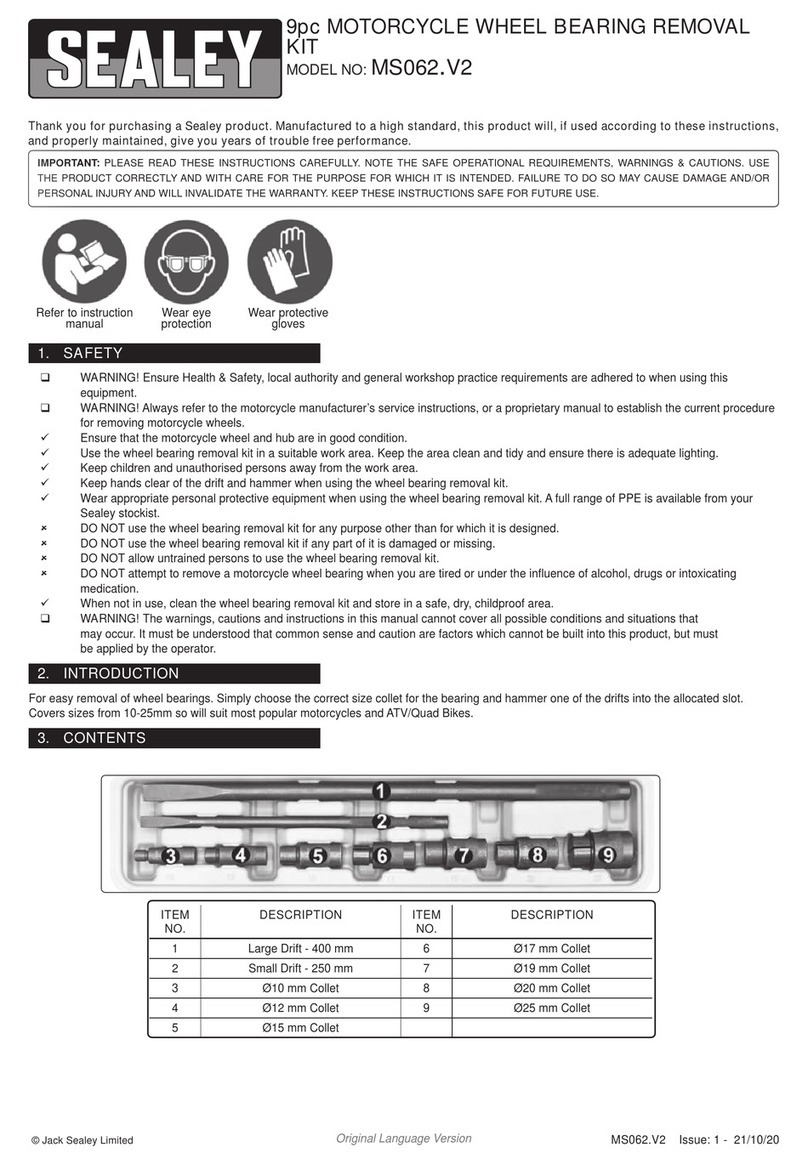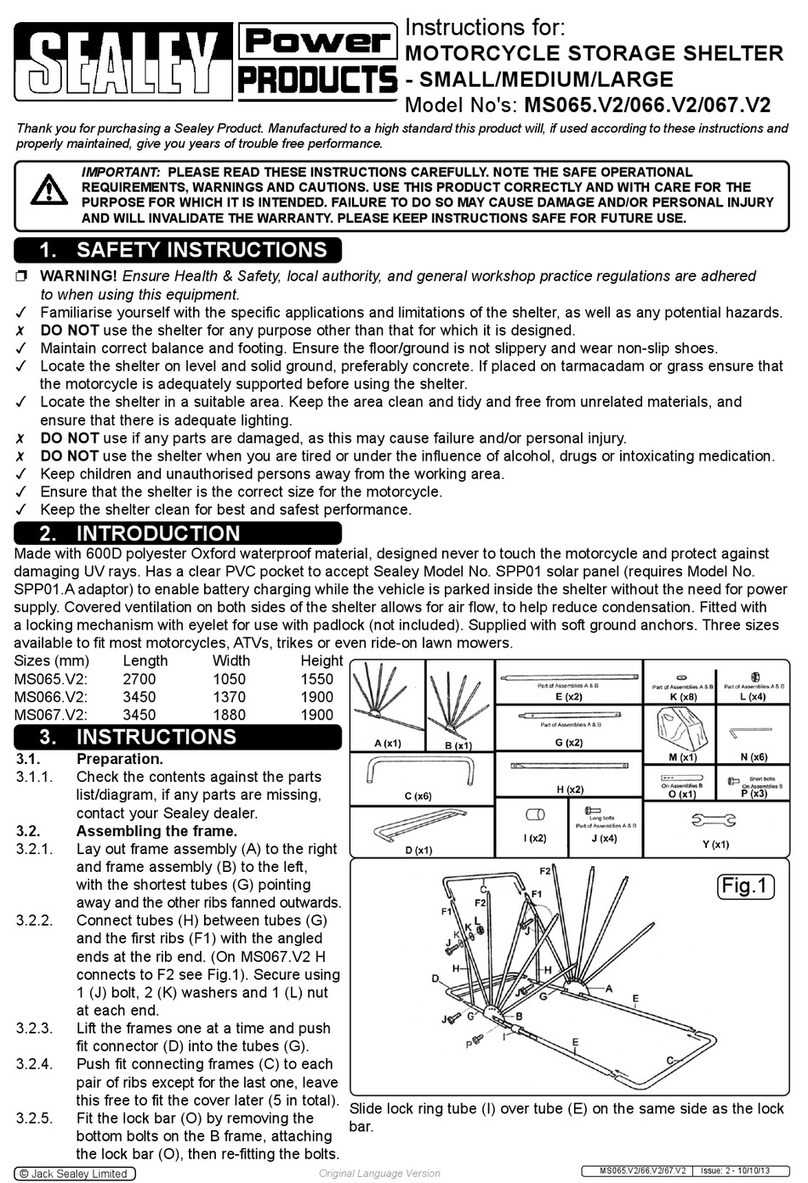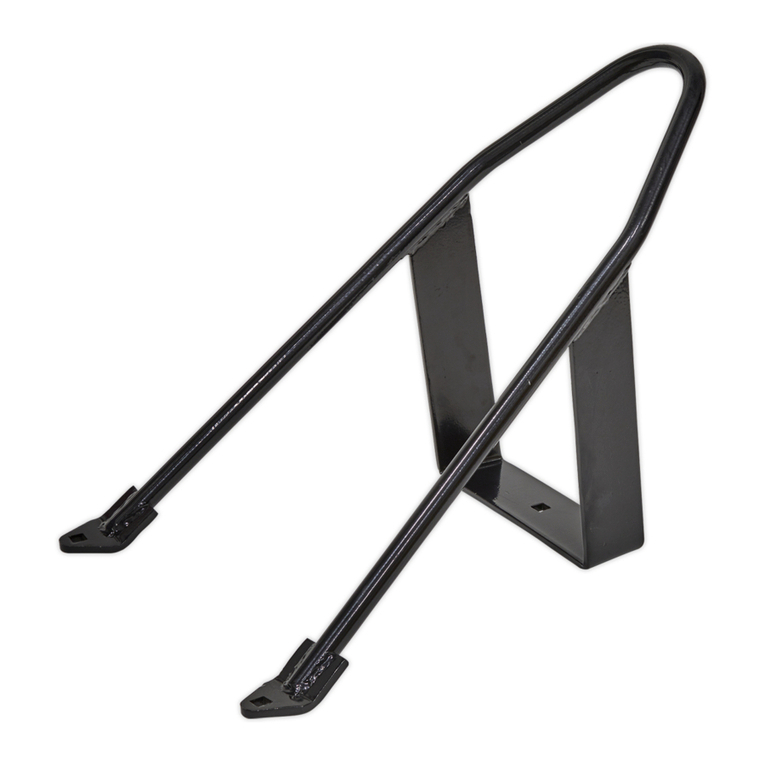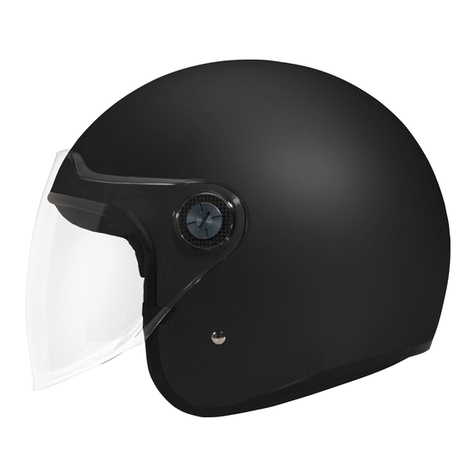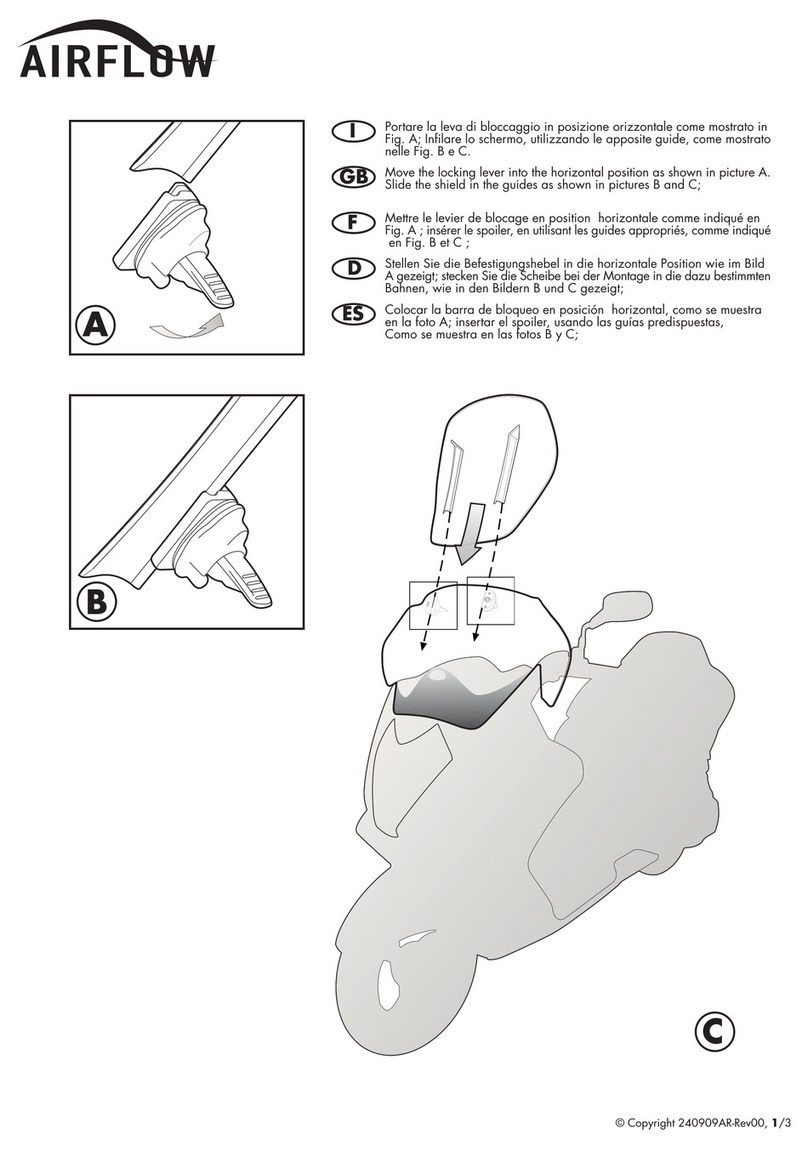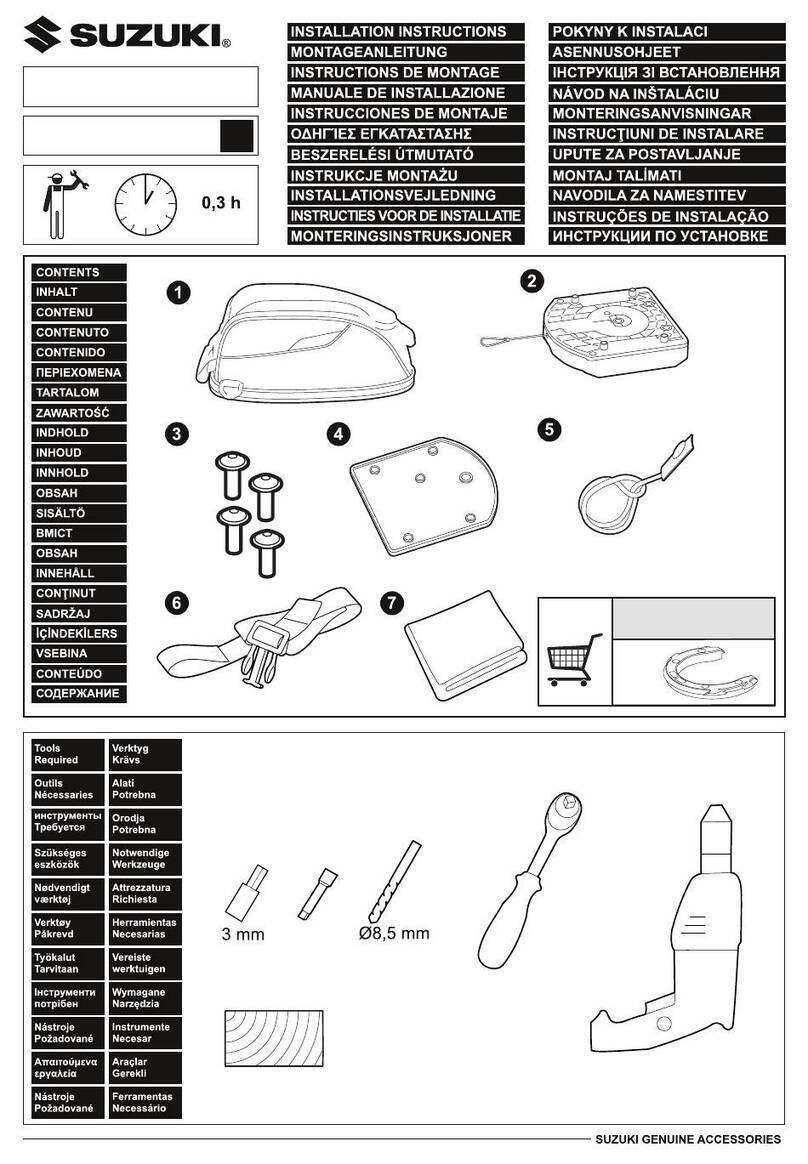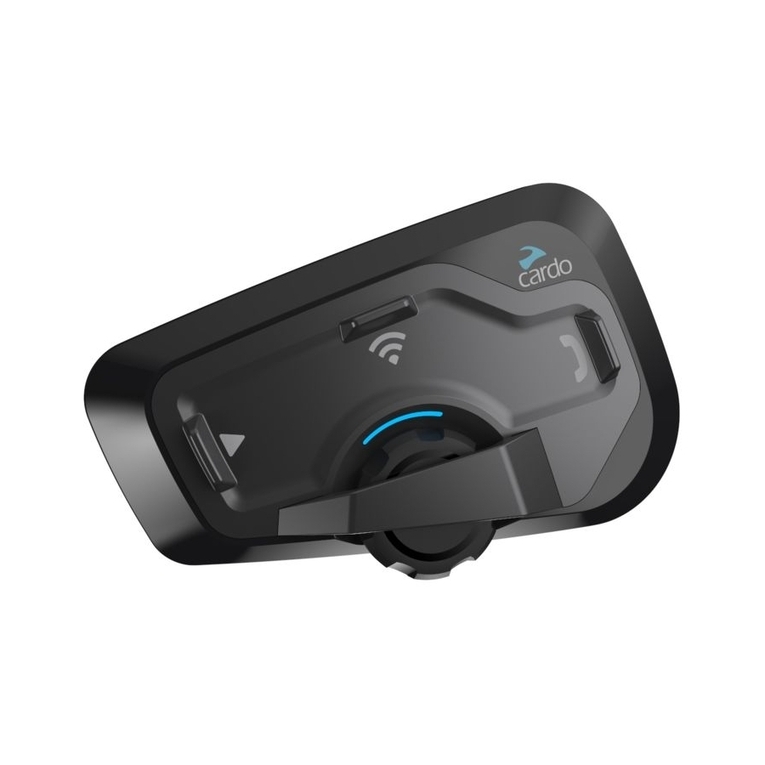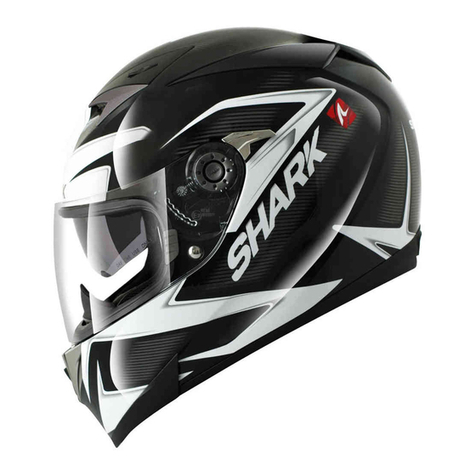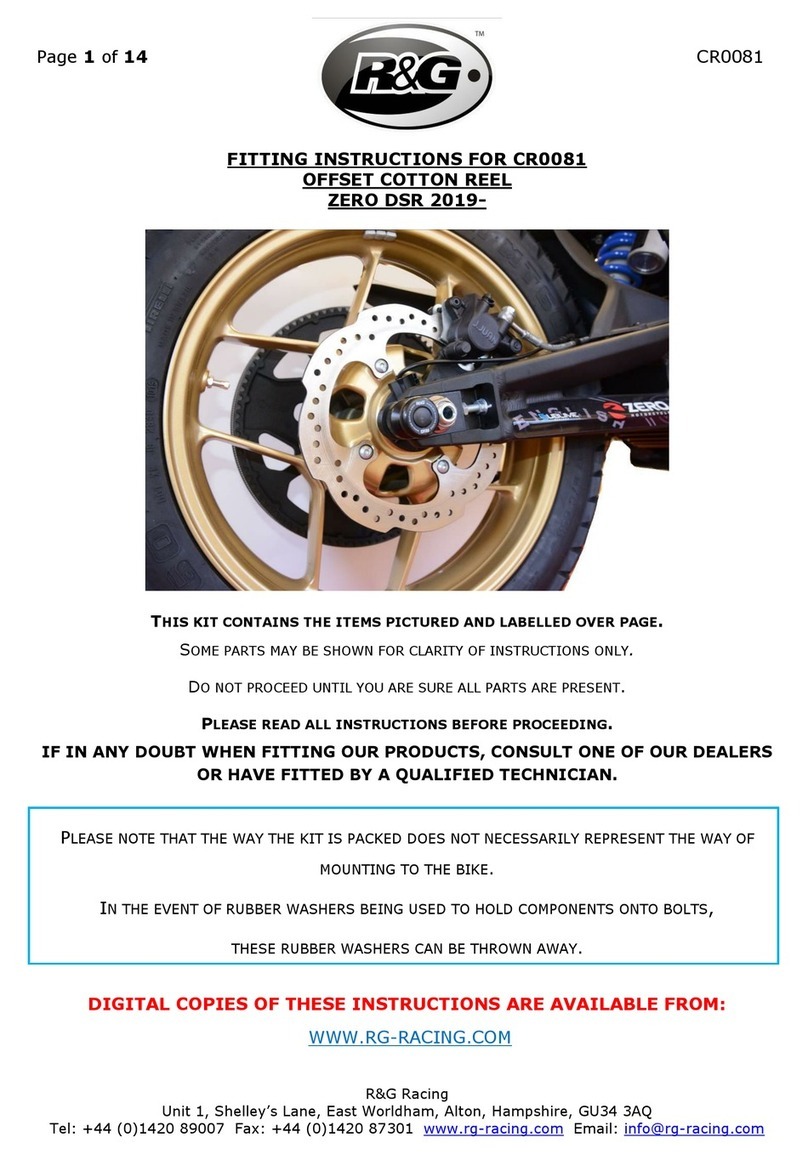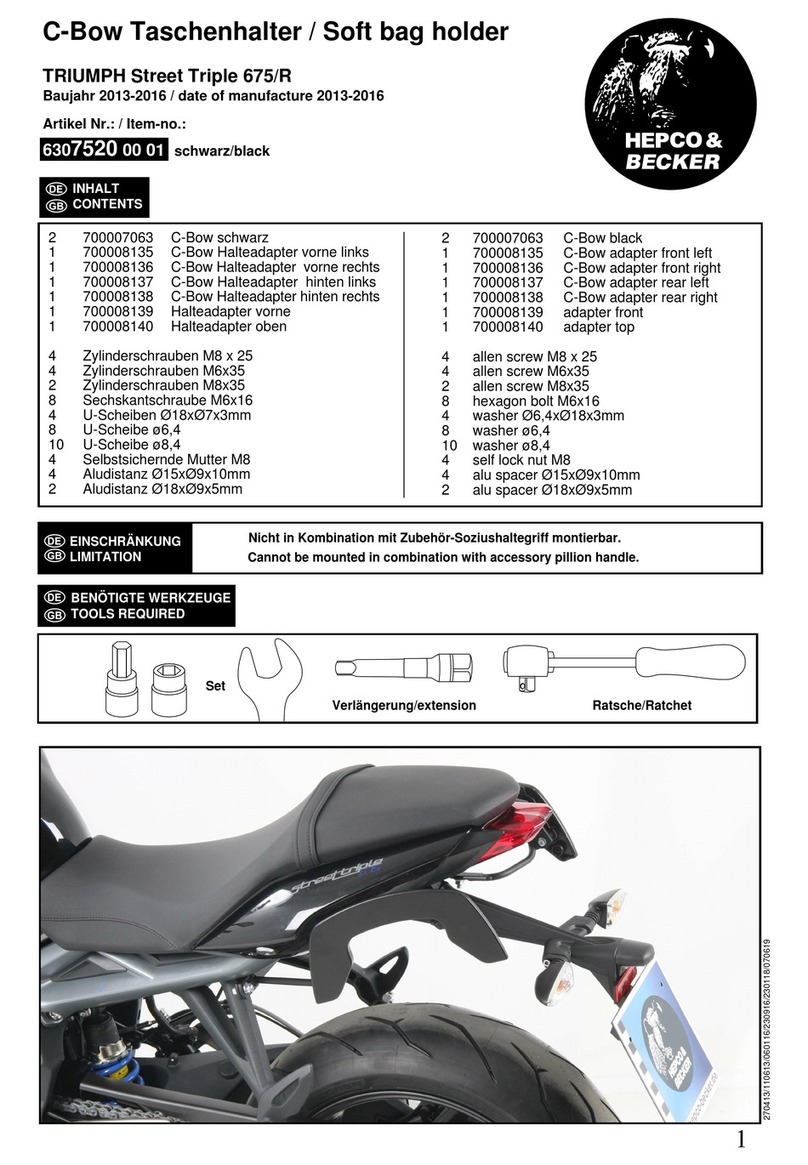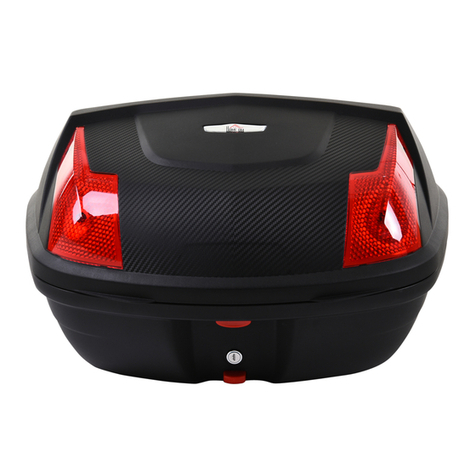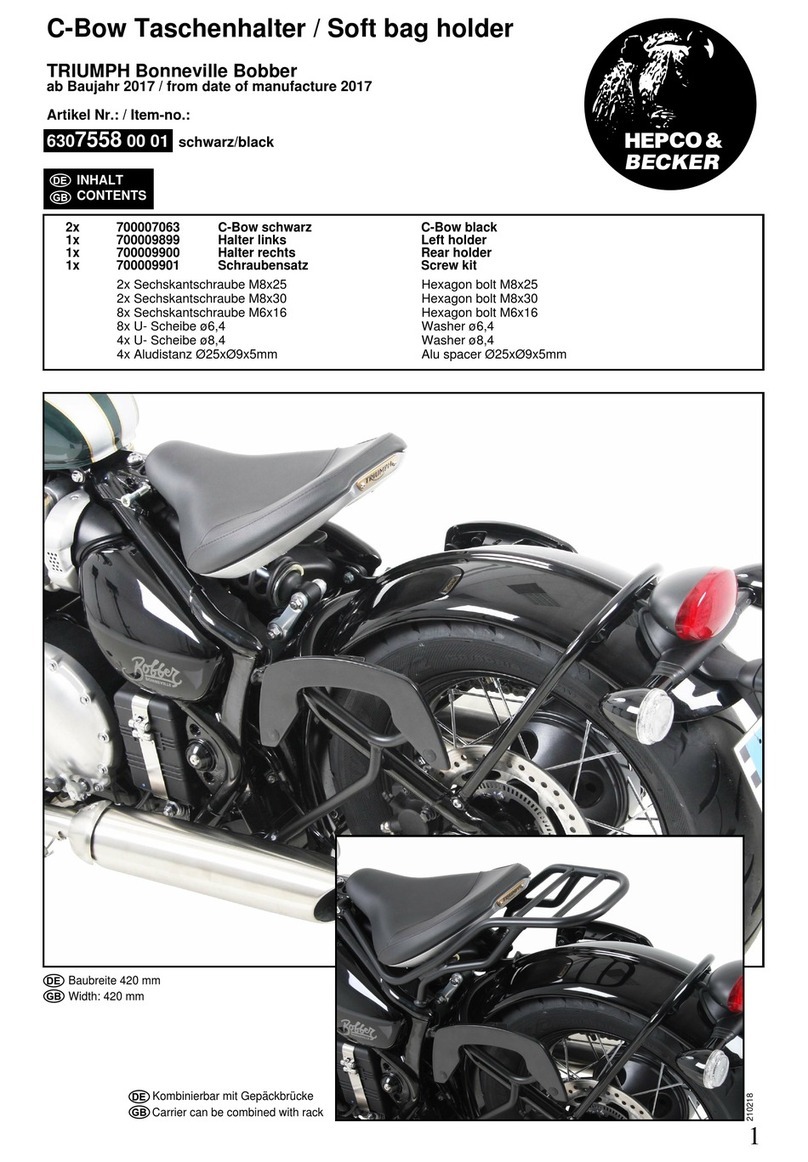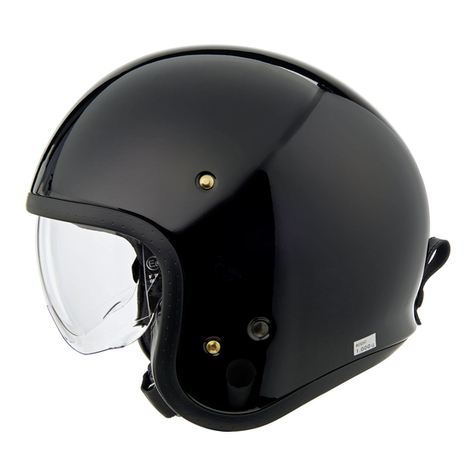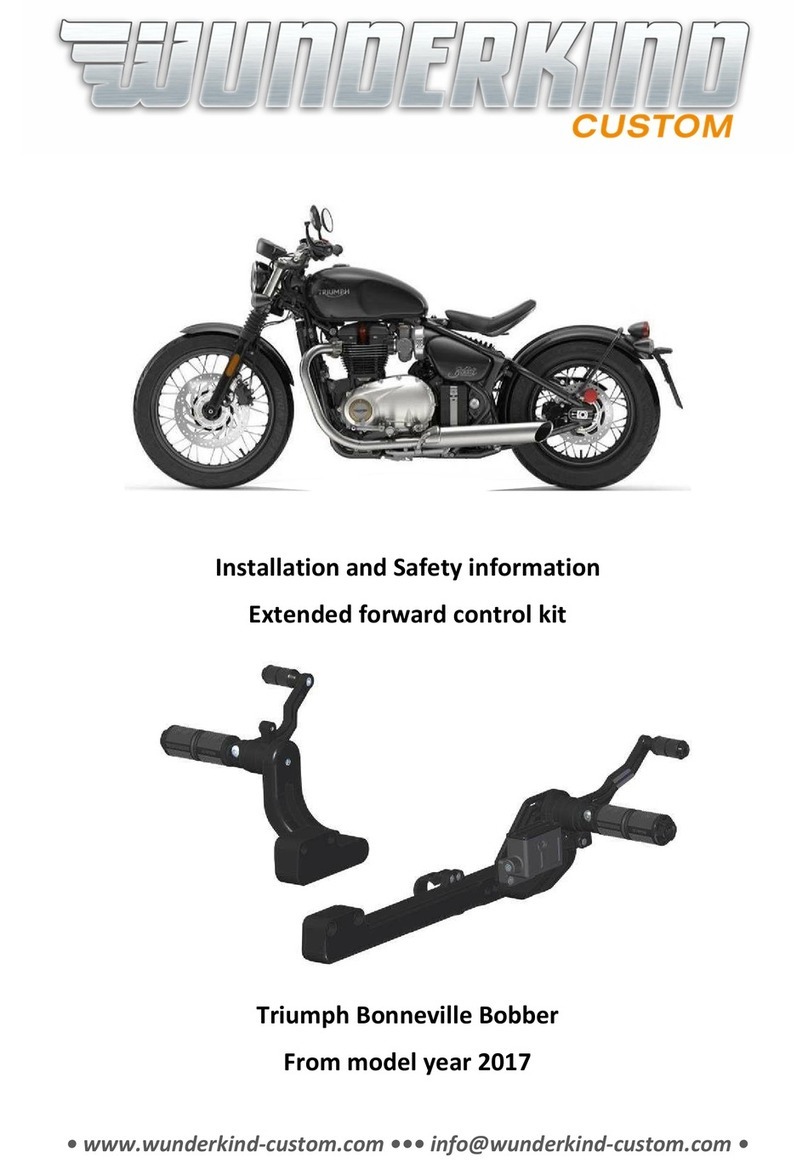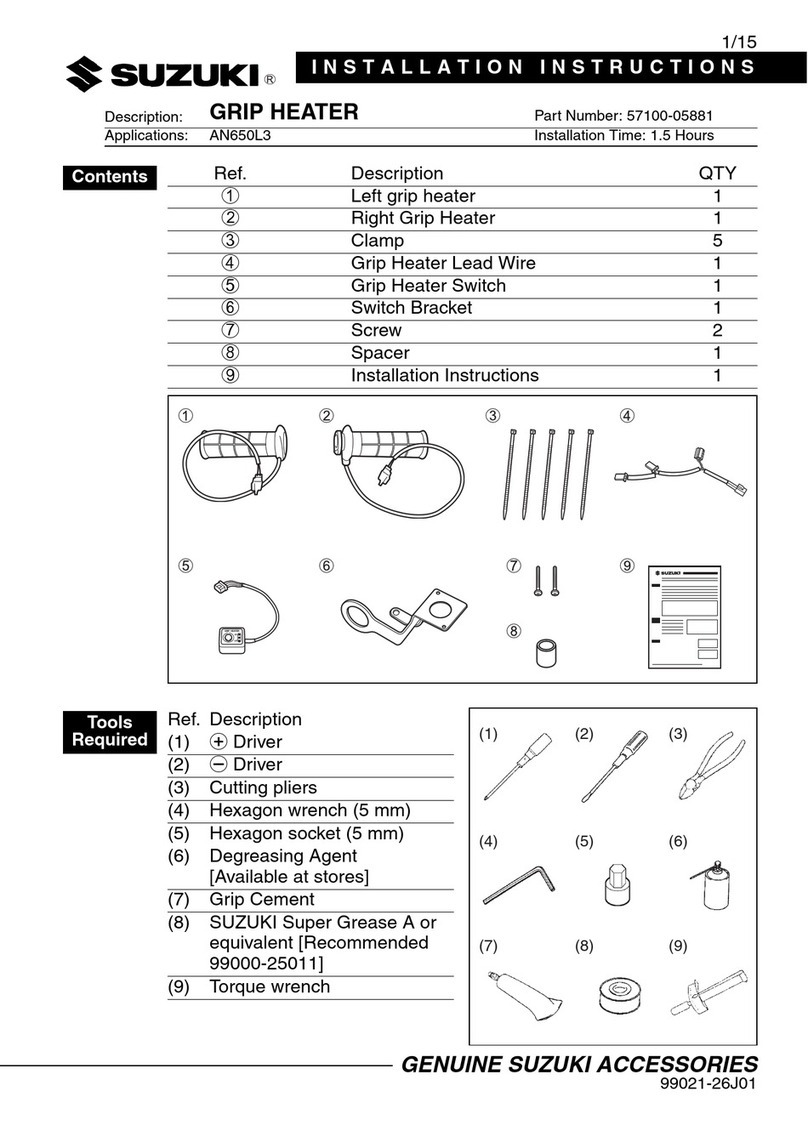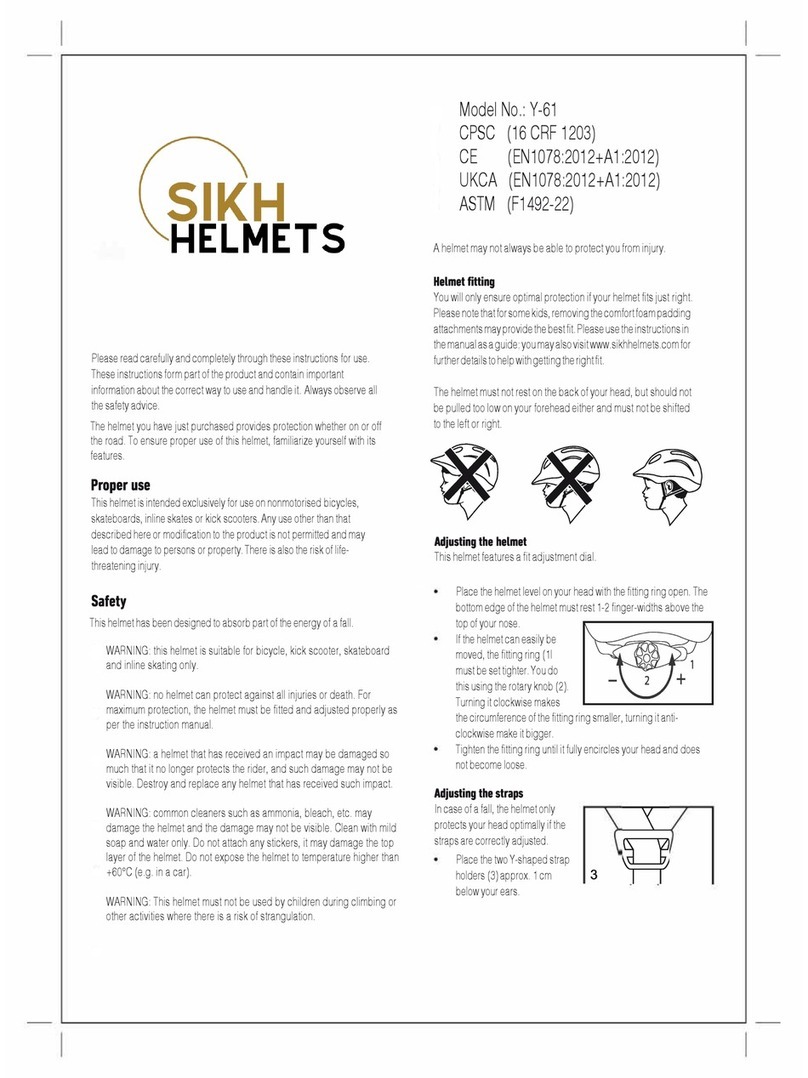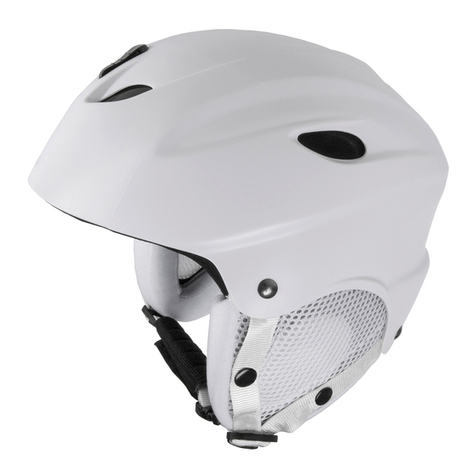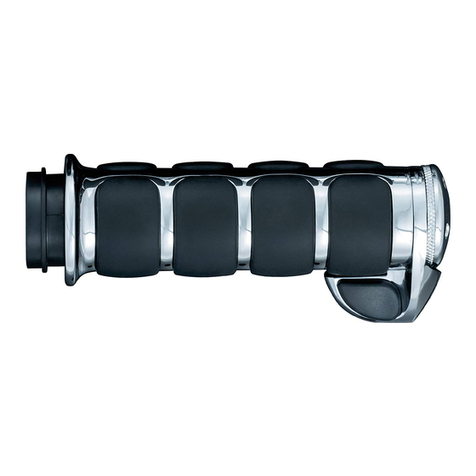Sealey PWH615 User manual

WELDING HELMET WITH AIR PURIFYING
RESPIRATOR AUTO DARKENING SHADE 5-8 & 9-13
MODEL NO: PWH615
Thank you for purchasing a Sealey product. Manufactured to a high standard, this product will, if used according to these
instructions, and properly maintained, give you years of trouble free performance.
IMPORTANT: PLEASE READ THESE INSTRUCTIONS CAREFULLY. NOTE THE SAFE OPERATIONAL REQUIREMENTS, WARNINGS & CAUTIONS. USE
THE PRODUCT CORRECTLY AND WITH CARE FOR THE PURPOSE FOR WHICH IT IS INTENDED. FAILURE TO DO SO MAY CAUSE DAMAGE AND/OR
PERSONAL INJURY AND WILL INVALIDATE THE WARRANTY. KEEP THESE INSTRUCTIONS SAFE FOR FUTURE USE.
1. SAFETY
WARNING! This helmet is not suitable for use with laser welding or CUTTING or for overhead welding applications.
9Ensure all workshop safety rules, regulations and conditions are complied with when using welding equipment. The helmet will not
offer protection against misuse of workshop tools, equipment, or accessories.
9Maintain the helmet in good condition and protect cartridge from liquid and dirt contact. Regularly replace the protective lens and
replace any damaged or worn parts. Use genuine parts only. Unauthorised parts may be dangerous and will invalidate the warranty.
9Ensure the front cover window is securely in place before use.
9Fit the helmet and adjust the head band so the helmet will sit as low and near to your face as possible.
9Use helmet only in temperatures ranging from -5°C to 55°C.
9 Removeillttingclothing,removeties,watches,ringsandotherloosejewellery.
9Maintain correct balance and footing.
9 Ensuretheoorisclearfromobstructions,notslipperyandwearnon-slipprotectiveshoes.
9Keep children and unauthorised persons away from the working area.
WARNING! The helmet will only protect the eyes and face from radiation and sparks. It will not protect against explosive devices or
corrosive liquids.
8DO NOT use helmet for any purpose for which it is not designed.
8DO NOTusehelmetunlessyouhavebeeninstructedinitsusebyaqualiedperson.
8DO NOT open or tamper with the shade cartridge.
8DO NOT get the helmet wet or use in damp or wet locations.
8DO NOT leave work place with helmet in lowered position, as bright light source may darken cartridge unexpectedly.
8DO NOT place the helmet on a hot surface.
8DO NOTusehelmetwithoutfrontcoverwindowtted.Todosowillinvalidateyourwarranty.
9Clean helmet (see section 5.5) and store the helmet in a safe, dry, childproof location.
WARNING!Beforeweldingalwaysinspectthecartridgeltertoensurethatitisnotdamaged.Totestthelterpriortowelding,direct
thefrontofthecartridgeltertoabrightlightsourcewhichwillcausethelenstodarken.Thenusingyourhandrapidlycoverand
uncoverthesensor.Theltershouldlightenmomentarilythenreturntoadarkstate.
WARNING! DO NOT use the helmet if damaged or you suspect it may be faulty. (Contact Sealey Stockist).
▲DANGER! DO NOT use if, at any time, the face plate in the cartridge FAILS to darken when exposed to a welding spark. Remove
cartridge and return to your Sealey stockist for checking.
9Continued use of the product knowing that the auto darkening feature is NOT FUNCTIONING may DAMAGE YOUR EYES and
CAUSE BLINDNESS.
▲DANGER! DO NOT wear this respirator system to enter areas where:
1.Atmospheresareoxygendecient.
2. Contaminant concentrations are unknown.
3. Contaminant concentrations are Immediately Dangerous to Life or Health.
4. Contaminant concentrations exceed the maximum use concentration determined using the assigned Protection Factor for the
specicrespiratorsystem.
WARNING!TheParticleltercannotbecleaned.DO NOT attempt to remove contamination using for example compressed air as
thiswilldestroythelters,theequipmentwillnotgivetheexpectedprotectionandthewarrantywillbeinvalidated.
9If ventilation is poor, wear an approved air-supplied respirator.
9Read and understand the Material Safety Data Sheets and the manufacturer’s instructions for metals, consumables, coatings,
cleaners, and degreasers.
9 Workinconnedspaceonlyifitiswellventilated,orwhilewearinganair-suppliedrespirator.Alwayshaveatrainedwatch-
person nearby. Welding fumes and gases can displace air and lower the oxygen level causing injury or death. Be sure the breathing
air is safe.
8DO NOT weld in locations near degreasing, cleaning, or spraying operations. The heat and rays of the arc can react with vapours to
form highly toxic and irritating gases.
8DO NOT weld on coated metals, such as galvanized, lead, or cadmium plated steel, unless the coating is removed from the weld
area, the area is well ventilated, and while wearing an air-supplied respirator. The coatings and any metals containing these
elements can give off toxic fumes if welded. RESPIRATOR (PAPR) MISUSE can be hazardous. Welding produces fumes and gases.
Breathing these fumes and gases can be hazardous to your health.
9Read and follow these instructions and the safety labels carefully. The powered air purifying respirator (PAPR) helps protect the
PWH615 Issue 1 15/08/19
Original Language Version
© Jack Sealey Limited
Refer to
instructions

userfromspecicairbornecontaminantsbutmustbeusedcorrectlytobefullyeffective.Haveanindustrialhygienisttesttheair
in your facility to ensure the PAPR provides adequate protection from contaminants in your environment. If you have questions
abouttherespirator,seeequipmentwarninglabelandconsultyourSafetyDirectorandacertiedIndustrialHygienist.
9Follow all applicable EN/ANSI/CSA/AS&NZS, and other regulatory guidelines pertaining to the use of respirators.
8DO NOTusethepoweredairpurifyingrespiratorwherethereisdangerofreorexplosion.
8DO NOT use the powered air purifying respirator in windy conditions or negative pressure inside the hood may draw in
contaminants from the outside air.
8DO NOT use the powered air purifying respirator without a properly installed spark guard cover. Without the spark guard cover,
weldingsparksmayignitethelter,ordamagethelterandallowunlteredairintothehelmet.
9The powered air purifying respirator does not supply oxygen. Use the respirator only in atmospheres for which it is EN/ANSI/CSA/
AS&NZS approved. DO NOT use the respirator where oxygen levels are 19.5% or lower, where contaminant levels are unknown or
areimmediatelydangeroustolifeorhealth,orwherethecontaminantlevelsexceedtherespiratorspecications.
8DO NOT enter a hazardous area until you are sure the respirator equipment is correctly assembled, working properly, and properly
worn.
9Before each use, inspect the respirator equipment for damage and verify it operates properly, Before using the respirator, test air
owtoverifyitisprovidinganadequatevolumeofair.
8DO NOTusethepoweredairpurifyingrespiratorwithoutallltercomponentsorwiththeblowerturnedoff,ashazardouslevelsof
oxygen and carbon dioxide may accumulate in helmet.
9Always wear the powered air purifying respirator when entering a contaminated area. DO NOT remove the respirator until outside
the contaminated area.
9Dangerous contaminants may not smell or be visible. Leave the area immediately if you notice the following:
-Breathingbecomesdifcult.
- You experience dizziness, impaired vision, or eye, nose, or mouth irritation.
- The powered air purifying respirator alarm sounds.
- The equipment is damaged.
-Airowdecreasesorstops.
- If you think the equipment is not supplying adequate protection.
8DO NOT remove the equipment until you are in a safe area.
8DO NOT repair, modify, or disassemble the powered air purifying respirator or use with parts or accessories not supplied by the
manufacturer. Use only those components that are part of the approved assembly.
9 Replacedamagedorcloggedlters.DO NOTwashorreuselters.DO NOTcleanltersbytappingorwithcompressedairorlter
elementsmaybedamaged.Disposeofusedlterelementsaccordingtolocal,state,andfederalrequirements.
9 Thepoweredairpurifyingrespiratormustbeusedwiththehelmet,hood,andltersrecommendedbythemanufacturertoprovidea
respirator system. See the label on the blower for information on the required equipment.
8DO NOT use the powered air purifying respirator belt or shoulder straps(if equipped) as a safety harness.
2. INTRODUCTION
PAPR(PoweredAir-PurifyingSystem)withAutoDarkeningWeldingHelmet.Highlyefcientltercaptureshazardousdust,mistsandfumes.
Lithium battery powered blower unit gives the user a cooling stream of air to their head and face for up to 8 hours. Features a loud audible
and visual alarm to alert user of low battery/low air. The welding helmet has adjustable shade control from 9-13. Fully automatic switching
from light to dark on striking arc. Additional shades 5-8 for gas welding/cutting. Solar panel power supply. Features sensitivity and delay
controls for switching light to dark. Contoured design helmet with adjustable headband for added comfort. Suitable for MIG, TIG and arc
welding. Complies with BS EN 379, BS EN 175 and DIN standards.
3. SPECIFICATION
Model No:...................................................................................................... PWH615
Grinding Function:.................................................................................................. Yes
Operating Temperature: ......................................................................... -5°C to +55°C
Operating Time Light/Dark: .................................................................................0.1ms
Power:......................................................... Solar Cells/Rechargeable Lithium Battery
Shade Active: .................................................................................5-8 & 9-13 Variable
Shade Inactive: .......................................................................................................... 4
Viewing Area: ..........................................................................................120 x 100mm
4. OPERATION
4.1. ADJUSTING THE HELMET
4.1.1. Adjust the headgear diameter with the twist knob on the back. The knob is locked until pushed in. Once unlocked, twist clockwise to
tighten and counter clockwise to loosen.
4.1.2. Adjust the height by snapping the pin on the top band into the hole
to lock securely in place.
4.1.3. To adjust the viewing angle, loosen the knob on both sides of the
helmet and change angle locker to the desired tilt position (5
selection and positioned in the middle by default). Once
achieving the desire angle, tighten the knobs until snug.
The helmet should still swing up, but it should not drift
downward when in place for welding.
4.1.4. To adjust the distance between the user’s face and ADF,
loosen the knobs on both sides of the helmet until the headband
can move back and forth freely, reposition the headband at one
of the 3 slots as desired (The headband is positioned in the
middle by default). This should be done one side at a time and
both sides should be located at the same position for proper
auto-darkeninglteroperation.
Forward/
backward
adjustment
Push in
thumbwheel and
turn to adjust
circumference
Tilt
adjustment
A
i
r
T
u
b
e
g.1
Original Language Version
© Jack Sealey Limited PWH615 Issue 1 15/08/19

4.2. SHADE GUIDE TABLE
4.3. SELF-CHECK
4.3.1. PresstheTESTButtonatanytimetoseeifitautomaticallyswitchestodarkstateandreleaseittocheckthatthelterreturnsto
the light state. Shade Control; Select the shade DIN 9 to 13 based upon the welding process you will use by consulting the
“Shade Guide Table”. The variable shade control knob is for internal adjustment. The welding helmet can also be used to
protectthefacewhencutting,fromshadeDIN5to8.GrindmodeDIN4preventslterlensfromauto-darkeningforgrindinguse.
4.4. SENSITIVITY CONTROL
4.4.1. The sensitivity can be set from LOW to HIGH by using
the sensitivity dial. The LOW setting suits excess
ambient light or with another welding machine close by.
The HIGH setting suits low amperage welding and welding
in areas with low light conditions, especially low amperage
argon arc welding. Selections between LOW and HIGH
are suitable for most of indoor and outdoor welding
operations.
4.5. DELAY CONTROL
4.5.1. When welding ceases, the viewing window automatically
changes from dark back to light but with a pre-set
delay to compensate. The delay time can be set from MIN
(0.1 sec) to MAX (1.0 sec), by Shade Delay Control
The minimum delay suits spot or short welds. The
maximum delay suits heavy current welding and reduces
eye fatigue from the arc. Selections between MIN and
MAX are suitable for most of indoor and outdoor welding
operations.
4.6. CLEANING AND STORING
4.6.1. Keepthesensors,solarcellandlterlensclean.Cleanlter
cartridge and helmet shell by using a soapy water solution and soft cloth.
8DO NOT use solvents or abrasive cleaning detergent. Switch the product to Grind Mode and put it in a clean, dry location for storage.
4.7. INSTALLING THE BATTERY
8DO NOT allow battery to get wet.
8DO NOT attempt to open the battery case.
9 Keepbatteryawayfromreorheat.
9 Chargebatterybeforerstuse.
4.7.1. Push the battery into blower body until battery snaps into
position. Press the button on the end to assist with this.
4.7.2. To release, push the button on the end in and pull out.
Battery CR2032
Battery CR2032
Shade Range Selection Switch
Test Button
Shade Delay Control
Sensitivity Control
Fine Shade Control
Grind/Weld Switch
g.2
g.3
Original Language Version
© Jack Sealey Limited PWH615 Issue 1 15/08/19

4.8. INSTALLING THE AIR FILTER
8DO NOTusetherespiratorwithouttheFoamPrelterand
HEPAFilterinstalled(g.4).
9 Replacedamagedordirtyairlter.
4.8.1. InstalltheHEPAFilterintothecover.InstalltheFoamPrelter
above the HEPA Filter. Push down the cover until it “clicks”
into position as shown.
NOTE: FilterScreenandFoamPrelterprotectsandincreasesthe
lifetimeoftheparticlelter
4.9. ATTACHING THE BREATHING TUBE
4.9.1. Insert tube connector into blower body outlet until snug
and then turn connector 1/8 turn to the right to lock it into
place(g.6).
4.9.2. Insert the breathing tube terminal 1 into the headgear terminal
and turn the tube clockwise until breathing tube locks in
position.
4.10. TEST AIR FLOW
4.10.1. Disconnectbreathingtubefromhood.Insertowmeterintobreathingtube(g.7).Holdowmeterstraightupand
start blower.
4.10.2. Theowmeterballshouldoataboveminimummark.Ifowmeterreadsminimumorbelow,pleasecheck
batteryandlterelements(g.5).
4.11. TESTING AIR FLOW ALARM
4.11.1. Disconnectbreathingtubefromhood.Startblowerandblockairowbyplacingyourhandovertheendof
breathingtube.Continueblockingairowuntilalarmsoundsandtheblowervibrates.Ifalarmdoesnotsound
andtheblowerdoesnotvibrate,checkbatteryandlterelement.
4.12. OPERATING THE CONTROLS (FIG.8)
4.12.1. TO START: Press On button for 1 second until the blower starts. The Danger ,Low Speed, High Speed
Indicator lights go on, then go out, the alarm sounds, and the blower vibrates momentarily. Then the blower
always starts at the low speed. Press the SELECT button to switch between low and high speeds.
4.12.2. TO STOP: Press Off button for 1 second until the audible alarm and blower stop. The Danger Indicator light goes
on,thealarmsounds,andblowervibratesifbatterypowerisloworairowisreducedduetoadirtylter,blocked
breathing tube, or other problem.
4.13. BATTERY LEVEL INDICATOR LIGHT
Greenlightgoeson:batterylevel≥90%
Yellowlightgoeson:30%≤batterylevel<90%
Redlightgoeson:10%<batterylevel<30%
Redlightash:batterylevel≤10%
Protective Cover
Foam Prefilter
Filter Screen HEPA Filter
Blower Body
Blower Body Outlet
g.4
Air Flow Meter
Minimum Mark
Breathing Tube Connector
g.5
Breathing Tube Connector
and Terminal
Blower Unit
g.6
g.7
Low Speed Indicator
High Speed Indicator
Power On/Off
Low/High Selection
Danger Indicator
Battery Level Indicator
g.8
Original Language Version
© Jack Sealey Limited PWH615 Issue 1 15/08/19

4.14. CHECKING THE RESPIRATOR BEFORE USE
Before using the respirator, check the following items:
9Face seal; Inspect the face seal and replace if damaged.
9 AirFilterAssembly;Verifytheairlterissuitablefortheapplication.Alsobesurethelterisundamaged,andsecurelyconnectedto
the blower assembly.
9Breathing Tube; Be sure the tube is undamaged and properly connected to the blower assembly and hood.
9Battery; Verify the battery is fully charged and securely connected to the blower assembly.
9 AirFlow;TestairowaccordingtoSection4.10.
9Air Flow Alarm; Turn on blower assembly and check for audible, visual, and vibratory alarms.
9Hood; Inspect the hood and replace if damaged.
5. MAINTENANCE
5.1. FRONT COVER LENS REPLACEMENT
5.1.1. Replace the front cover lens if it is damaged (cracked, scratched, pitted or dirty). Remove the old front cover lens by pressing two
lock switches at the bottom of the retaining frame and pull the frame and ADF out. Take the old front cover lens out, and remove any
protectivelmbeforeinstallingthenewone.
5.2. INSIDE COVER LENS REPLACEMENT
5.2.1. Replacetheinsidecoverlensifitisdamaged(cracked,scratched,pittedordirty).Placeyourngerorthumbintotherecessandex
theinsidecoverlensupwardsuntilitreleasesfromoneedge.Thenremoveanyprotectivelmbeforeinstallingthenewone.
5.3. BATTERIES REPLACEMENT
5.3.1. When Low Voltage Indicator turns red, you have to change the batteries. Replace batteries by removing ADF from the retaining frame.
Slide cover plates on the top left and right, and replace the old batteries with lithium batteries. After that, put on cover plates of
batteriesandinstallADFbacktoframe(g.9).
5.4. REPLACING THE FILTERS
5.4.1. Pushdownthecoveruntilit“clicks”intopositionasshown(g.10),liftthetopcoverandremovethelter.
5.5. CLEANING:
5.5.1. Detach the battery pack, breathing tube and the blower. Inspect all parts for damage. Replace all damaged parts prior to storage or
next use.
A. Blower: Clean the outer surfaces of PAPR assembly and battery pack with a soft cloth dampened in a solution of water and mild,
pH neutral detergent. DO NOT immerse the blower or battery pack in water. DO NOT use solvents or abrasive cleaners. DO NOT
attempt to clean the interior of the blower with compressed air or vacuum. Ensure the electrical contacts of the blower and battery pack
are dry.
B. Breathing tube: Clean the connection sites on the breathing tube with the water and detergent solution. The breathing tube can be
immersed in water for cleaning. The inside of the tube must be completely dried prior to use or storage. Air dry, or dry by connecting to
the blower unit and use it to force air through the tube until dry.
C.HEPAlter:OpentheltercoverandinspecttheHEPAlter.Replaceifexcessivelydirty.
5.6. STORAGE:
Iftheblowerwillnotbeusedforanextendedperiod,removethelterandbatteryandstoretheminaclean,dry,coolplacefreeof
solvent-based vapours.
g.10
g.9
Original Language Version
© Jack Sealey Limited PWH615 Issue 1 15/08/19

6. TROUBLESHOOTING
6.1. WELDING SHIELD;
PROBLEM POSSIBLE CAUSES SUGGESTED SOLUTIONS
Difculttoseethroughlter Cover lens dirty Clean or replace cover lens
Filter lens dirty Cleanlterlens
Filter does not darken when arc is struck Grind Mode Selected Adjust to ‘Weld’ mode.
Sensors or Solar Panel blocked Make sure sensors or solar panel are
exposed to weld arc without blocking
Set Sensitivity to LOW Adjust Sensitivity to required level
Low voltage of lithium batteries Replace with new lithium batteries if indicator
turns red
Filter darkens without arc Set Sensitivity to HIGH Adjust Sensitivity to required level
Filter remains dark after welding Set Delay to MAX Adjust Delay to required level
6.2. FILTER AND HOOD;
FAULT POSSIBLE SOLUTION
Blower does not supply air to hood 1. Press on to start blower
2. Recharge battery
3. Verify battery is properly connected to blower
4. Remove blockage from blower outlet and breathing tube
Battery pack’s charge lasts less than
expected
1. Ensure battery pack is fully charged
2. Replace battery
3. Replace charger
4.Checktheairlter(HEPAlter&Foamprelter),andreplaceitifnecessary
Blower cannot be turned off Press ON/OFF button for one second
Batteryredlevellightisashing Charge or replace the battery
Danger light is on, alarm sounds or blower
vibrates
Checktheblowerairowassection4.10
Sealey Group, Kempson Way, Suffolk Business Park, Bury St Edmunds, Suffolk. IP32 7AR
01284 757500 01284 703534 sales@sealey.co.uk www.sealey.co.uk
ENVIRONMENT PROTECTION
Recycle unwanted materials instead of disposing of them as waste. All tools, accessories and packaging should be sorted, taken to
a recycling centre and disposed of in a manner which is compatible with the environment. When the product becomes completely
unserviceable and requires disposal, drain any fluids (if applicable) into approved containers and dispose of the product and fluids
according to local regulations.
WEEE REGULATIONS
Dispose of this product at the end of its working life in compliance with the EU Directive on Waste Electrical and Electronic Equipment
(WEEE). When the product is no longer required, it must be disposed of in an environmentally protective way. Contact your local solid
waste authority for recycling information.
BATTERY REMOVAL
Under the Waste Batteries and Accumulators Regulations 2009, Jack Sealey Ltd are required to inform potential purchasers of products
containing batteries (as defined within these regulations), that they are registered with Valpak’s registered compliance scheme. Jack
Sealey Ltd’s Batteries Producer Registration Number (BPRN) is BPRN00705.
Note: It is our policy to continually improve products and as such we reserve the right to alter data, specifications and component parts without prior
notice.
Important: No Liability is accepted for incorrect use of this product.
Warranty: Guarantee is 12 months from purchase date, proof of which is required for any claim.
Original Language Version
© Jack Sealey Limited PWH615 Issue 1 15/08/19

PWH Issue 1 15/08/19
Sealey Group, Kempson Way, Suffolk Business Park, Bury St Edmunds, Suffolk. IP32 7AR
01284 757500 01284 703534 sales@sealey.co.uk www.sealey.co.uk
Page 1 of 2
NOTE: It is our policy to continually improve products and as such we reserve the right to alter data, specifications and component parts without prior notice.
There may be alternative versions of this product, please contact us should you require this information.
IMPORTANT: No liability is accepted for incorrect use of product. Spare parts must be fitted by a competent person
WARRANTY: Guarantee is 12 months from purchase date, proof of which will be required for any claim.
Parts Information:
Welding Helmet with Air Purifying
Respirator Auto Darkening Shade 5-8 &
9-13
Model No: PWH615
Item Part No. Description
1 PWH.H Helmet
2 PWH.H Front Cover Lens
3 PWH.H Rubber Gasket Seal
4 PWH.H Auto-Darkening Cartridge
5 PWH.H Welding Cartridge Frame
Item Part No. Description
6 PWH.H Headgrear Height Adjusting Pin
7 PWH.H Headgrear Diameter Adjusting Knob
8 PWH.H Headgrear Angle & Distance Adjusting Knob
9 PWH.H Protective Plate
Item Part No. Description
1 PWH. Battery
2 PWH.A Lock for Battery

PWH Issue 1 15/08/19
Sealey Group, Kempson Way, Suffolk Business Park, Bury St Edmunds, Suffolk. IP32 7AR
01284 757500 01284 703534 sales@sealey.co.uk www.sealey.co.uk
Page 2 of 2
NOTE: It is our policy to continually improve products and as such we reserve the right to alter data, specifications and component parts without prior notice.
There may be alternative versions of this product, please contact us should you require this information.
IMPORTANT: No liability is accepted for incorrect use of product. Spare parts must be fitted by a competent person
WARRANTY: Guarantee is 12 months from purchase date, proof of which will be required for any claim.
Parts Information:
Welding Helmet with Air Purifying
Respirator Auto Darkening Shade 5-8 &
9-13
Model No: PWH615
Item Part No. Description
1 PWH.RU Filter Body
2 PWH. Filter
3 PWH.RU Form Filter
Item Part No. Description
4 PWH.RU Filter Screen
5 PWH.RU Filter Cover
Item Part No. Description
1 PWH.M Headshield
2 PWH.M Face Seal
3 PWH.M Headgear Terminal
4 PWH.M Breathing Tube (A)
5 PWH.M Breathing Hose
6 PWH.M Breathing Tube (B)
7 PWH.M Respirator Unit
8 PWH.M Belt
9 PWH.M Respirator Connector
Table of contents
Other Sealey Motorcycle Accessories manuals
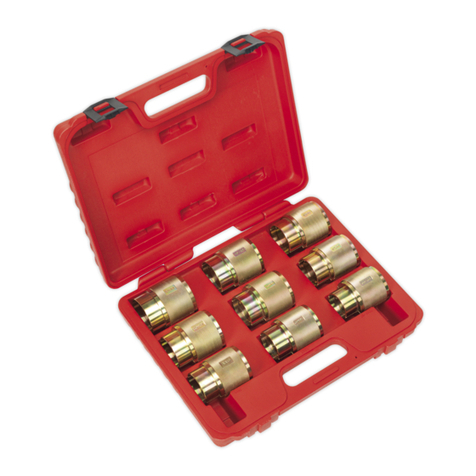
Sealey
Sealey MS018.V2 User manual
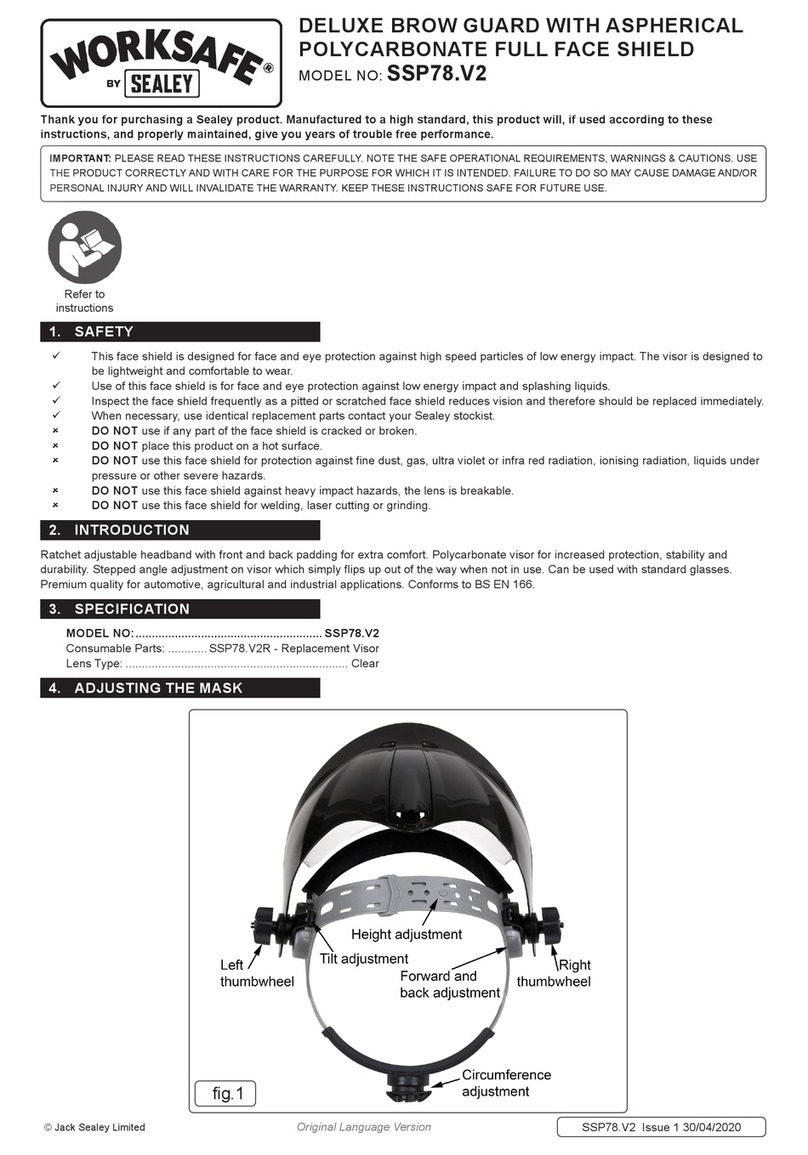
Sealey
Sealey WORKSAFE SSP78.V2 User manual
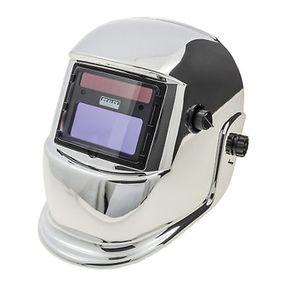
Sealey
Sealey PWH598 Series User manual
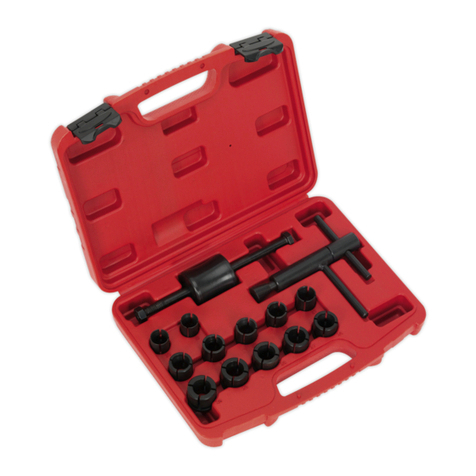
Sealey
Sealey MS162 User manual

Sealey
Sealey MS052.V2 User manual
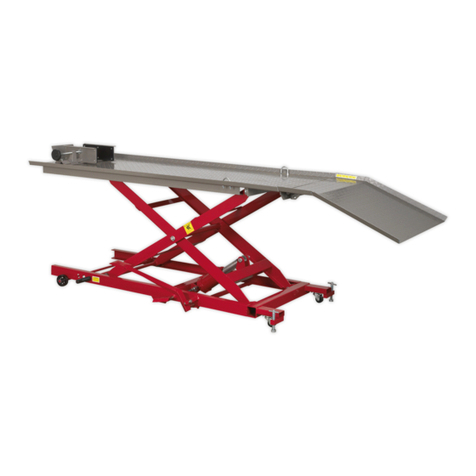
Sealey
Sealey mc454 User manual

Sealey
Sealey FPS6.V3 User manual

Sealey
Sealey Siegen Tools S01001.V3 User manual
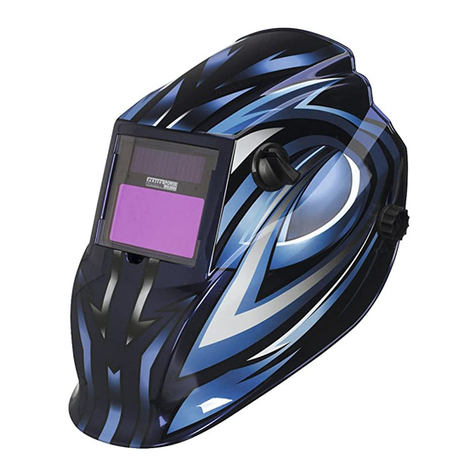
Sealey
Sealey PWH699R User manual
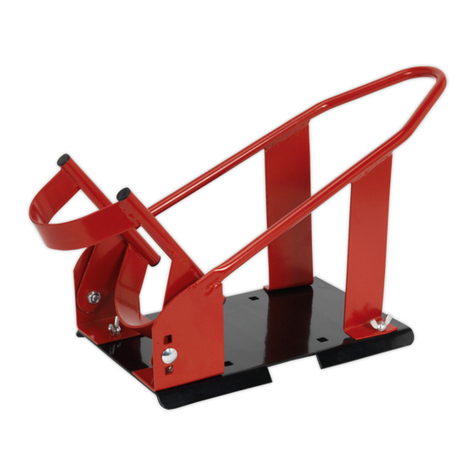
Sealey
Sealey FPS6 User manual
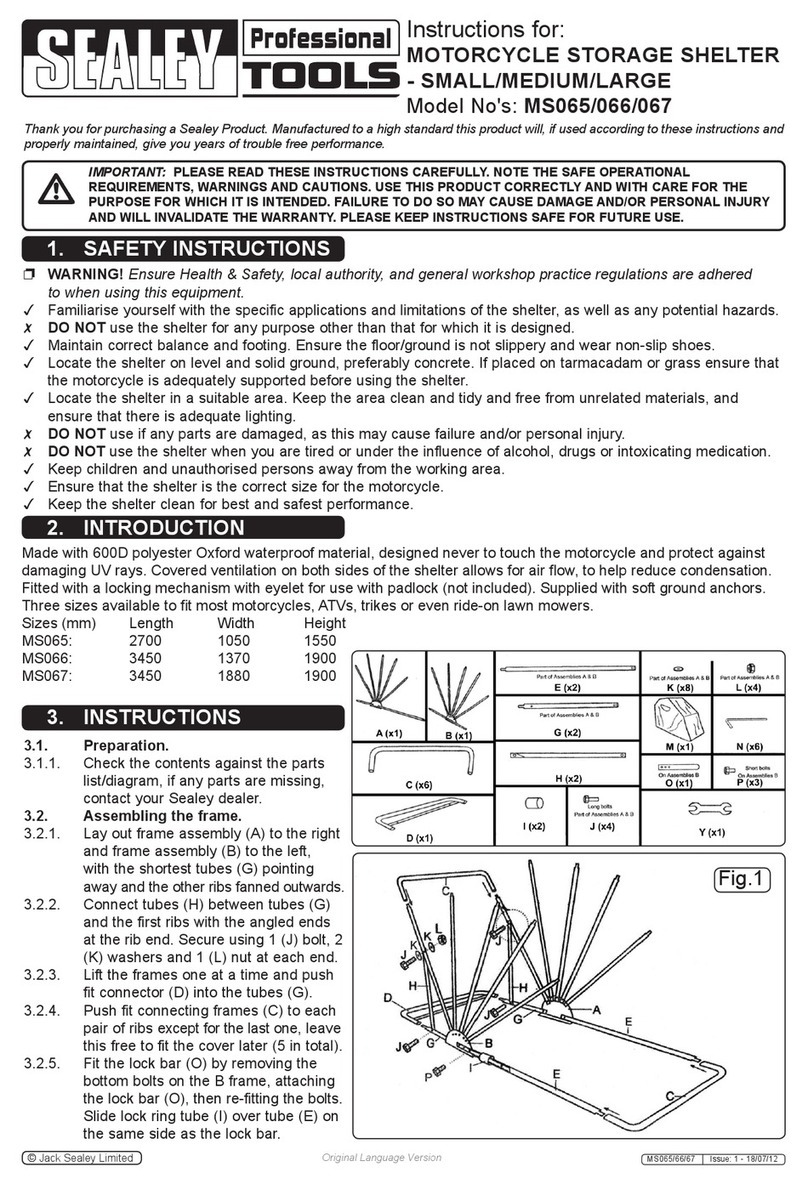
Sealey
Sealey MS065 User manual
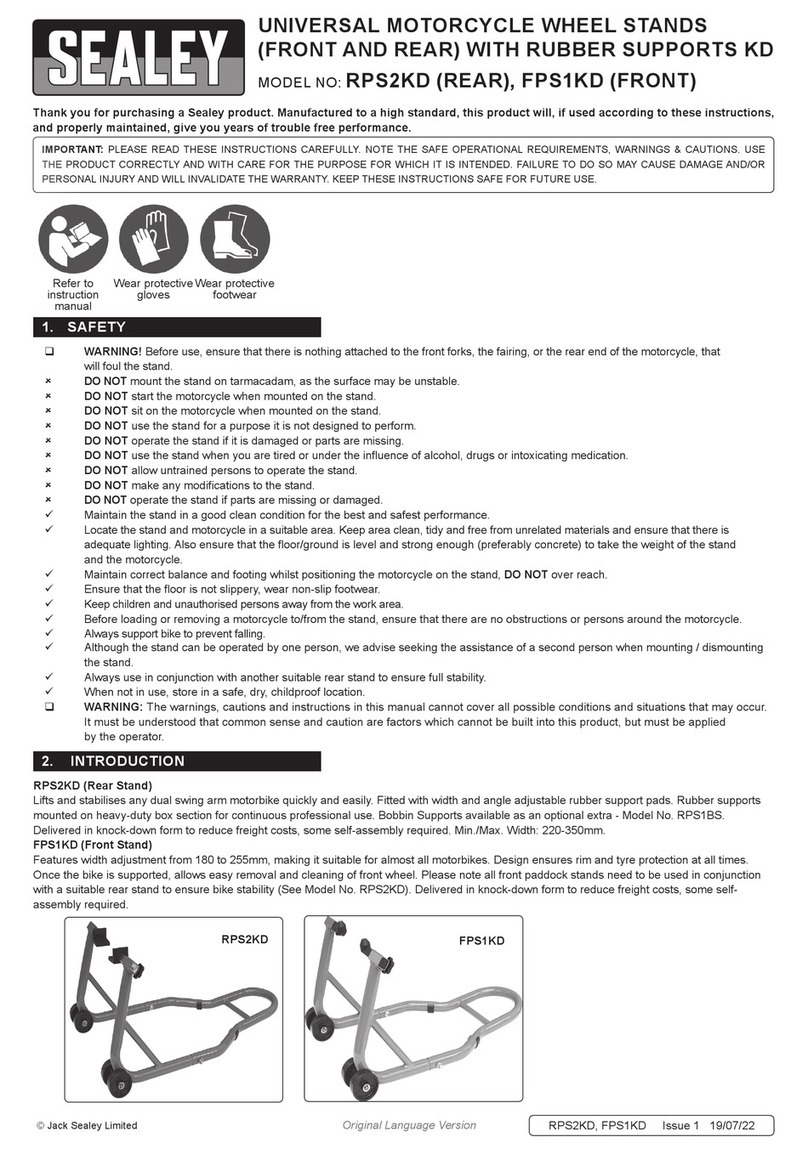
Sealey
Sealey RPS2KD User manual
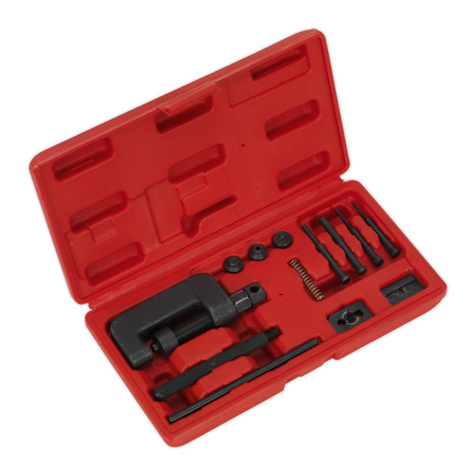
Sealey
Sealey VS779.V3 User manual
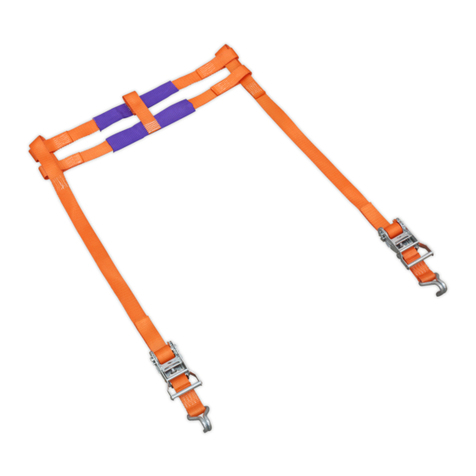
Sealey
Sealey TDMCRW User manual
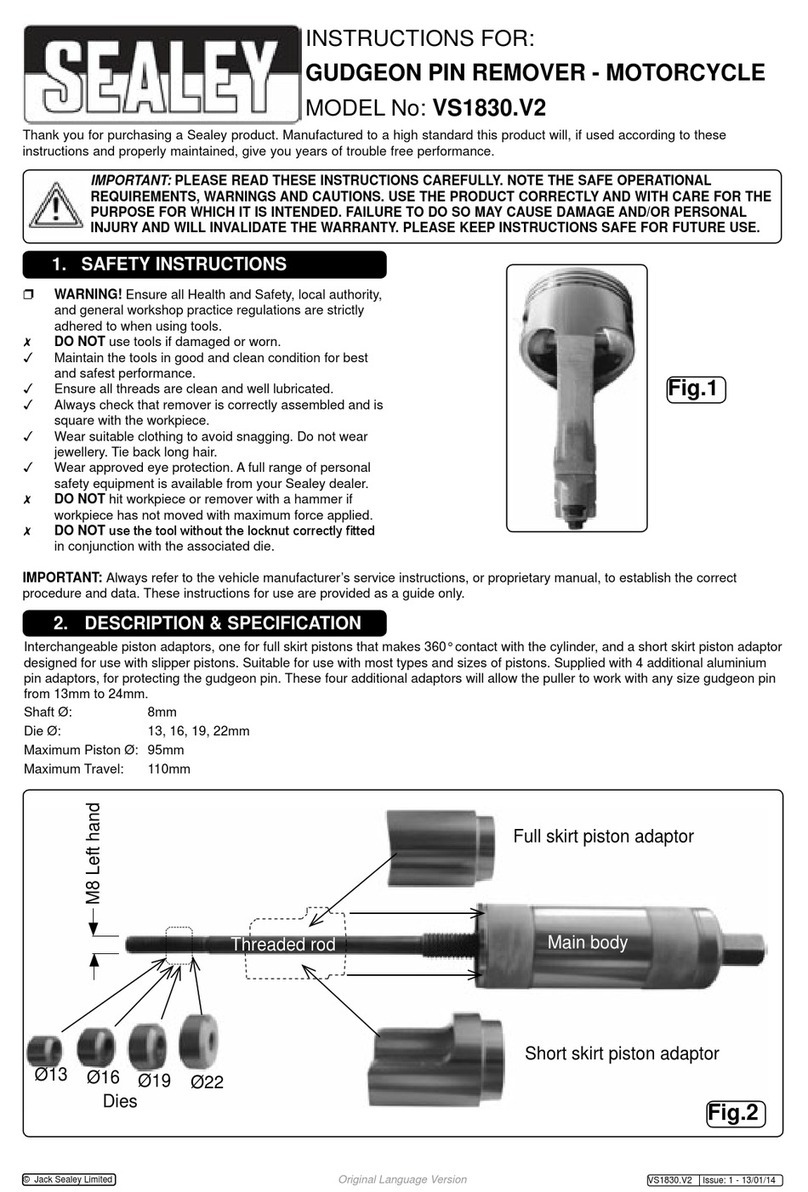
Sealey
Sealey VS1830.V2 User manual
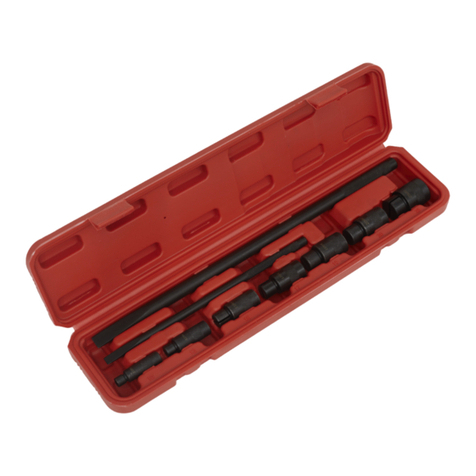
Sealey
Sealey MS062 User manual
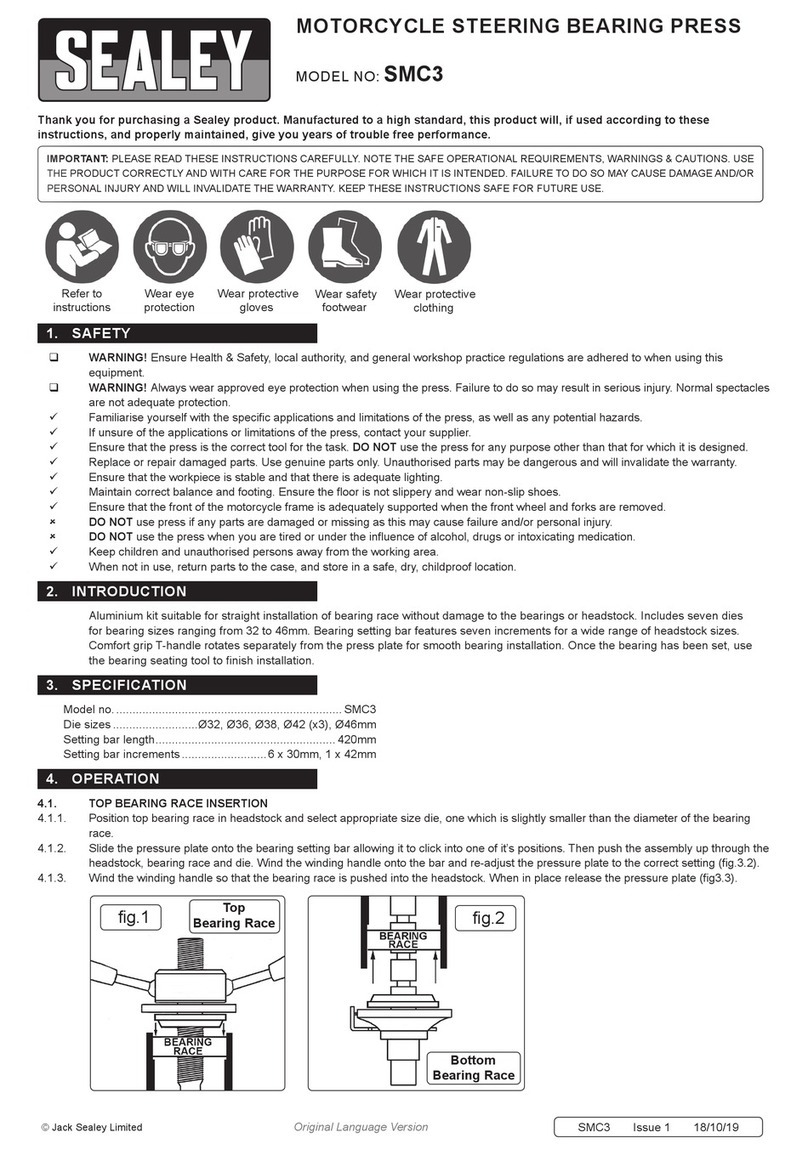
Sealey
Sealey SMC3 User manual
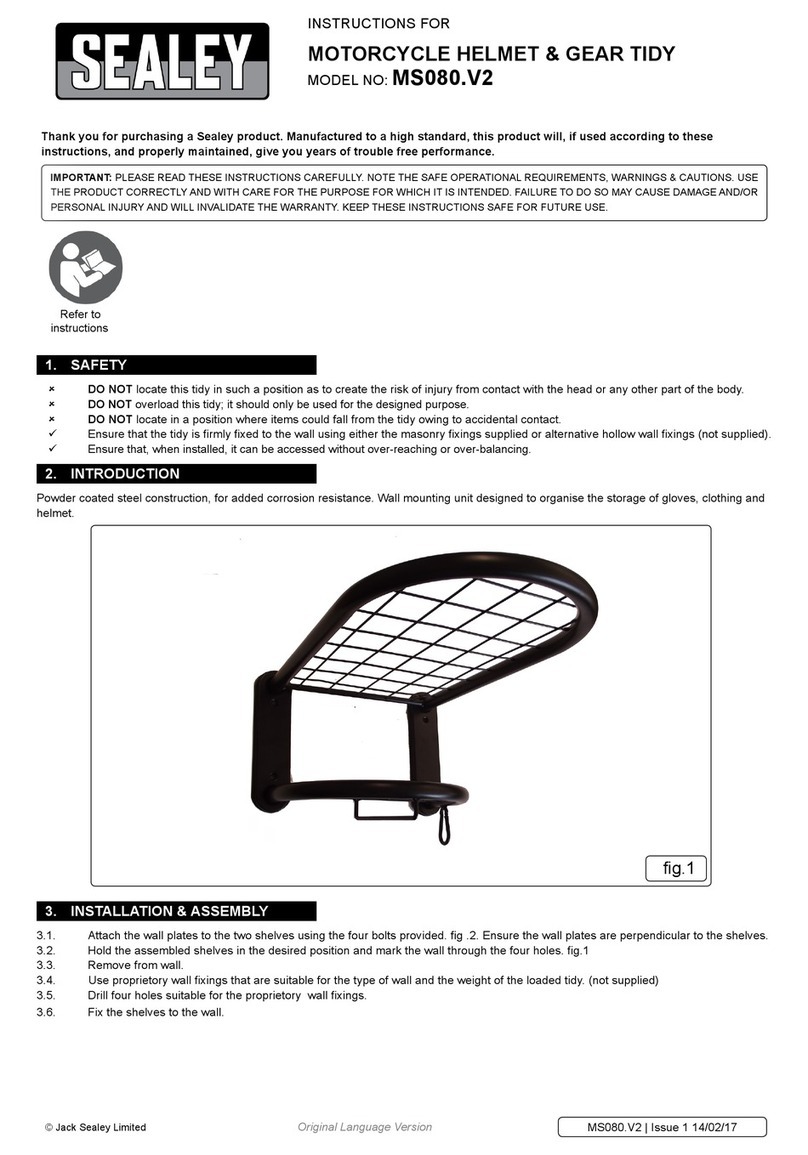
Sealey
Sealey MS080.V2 User manual
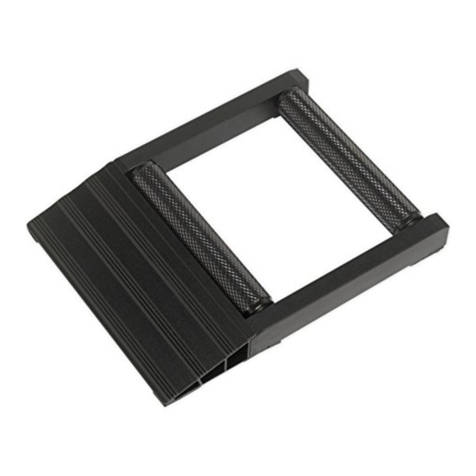
Sealey
Sealey MCRS1 User manual
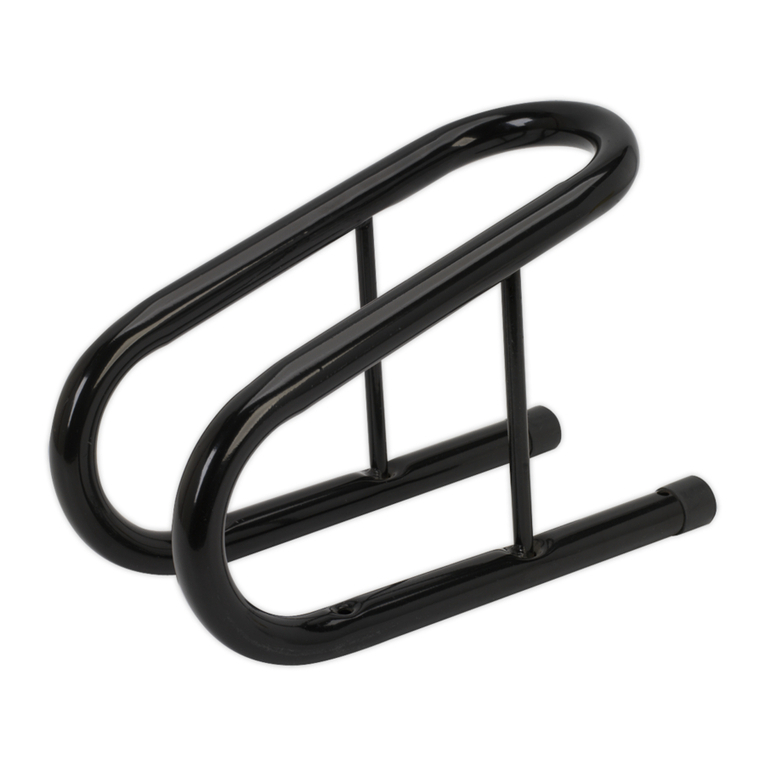
Sealey
Sealey WC06 User manual

